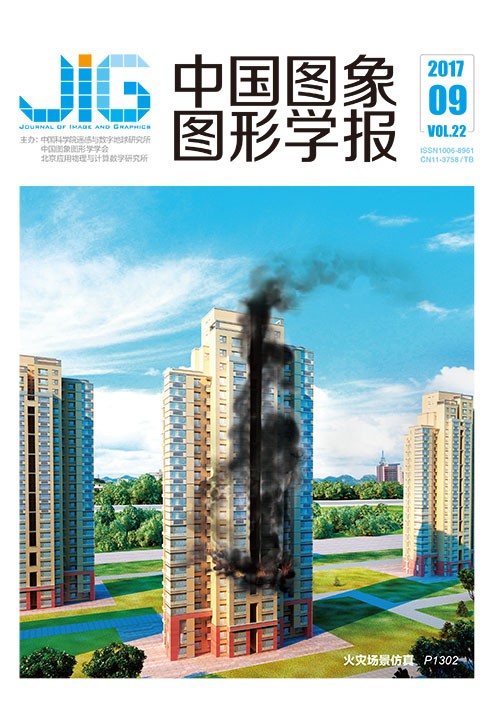
分段迭代匹配追踪图像重构算法
摘 要
目的 压缩采样匹配追踪(CoSaMP)算法虽然引入回溯的思想,但其原子选择需要大量的观测值且在稀疏度估计不准确时,会降低信号重构精度,增加重构时间,降低重构效率。为提高CoSaMP算法的重构精度,改善算法的重构性能,提出了一种基于广义逆的分段迭代匹配追踪(StIMP)算法。方法 为保证迭代时挑选原子的精确性和快速性,对观测矩阵广义逆化,降低原子库中原子的相干性;原子更新结合正交匹配追踪(OMP)算法筛选原子的准确性与CoSaMP算法的回溯性,将迭代过程分为两个阶段:第1阶段利用OMP算法迭代K/2次;第2阶段以第1阶段OMP算法迭代所得的残差和原子为输入,并采用CoSaMP算法继续迭代,同时改变原子选择标准,从而精确快速地重构出稀疏信号。结果 对于1维的高斯随机信号,无论在不同的稀疏度还是观测值下,相比于OMP、CoSaMP、正则化正交匹配追踪(ROMP)算法和傅里叶类圆环压缩采样匹配追踪(FR-CoSaMP)算法,StIMP算法更加稳健,且具有更高重构成功率;对于2维图像信号,在各个采样率下,StIMP算法的峰值信噪比(PSNR)均高于其他重构算法,在采样率为0.7时,StIMP算法的平均PSNR值比OMP、CoSaMP、ROMP和FR-CoSaMP算法分别高2.14 dB、1.20 dB、3.67 dB和0.90 dB,平均重构时间也较OMP、CoSaMP和FR-CoSaMP算法短。结论 提出了一种改进的重构算法,对1维高斯随机信号和2维图像信号均有更好的重构效率和重构效果,与原算法和现有的主流图像重构方法相比,StIMP算法更具高效性和实用性。
关键词
Image reconstruction method based on a piecewise iterative matching pursuit algorithm
Shi Manman, Li Lei, Yang Zhenzhen(College of Science, Nanjing University of Posts and Telecommunications, Nanjing 210023, China) Abstract
Objective Greedy algorithms for compressed sensing have received considerable attention because of their low computational complexity,high speed,and good recovery performance in image reconstruction.As a typical reconstruction method in greedy algorithms,the compressed sampling matching pursuit (CoSaMP) algorithm exhibits good robustness and can guarantee the reconstruction of signals from arbitrary observation noise background.However,the CoSaMP algorithm requires a large number of observations in the atom selection process,which affects reconstruction time.The principle of atom selection can also lead to the inaccurate estimation of a support set to reduce reconstruction precision.Therefore,a stagewise iterative matching pursuit (StIMP) algorithm based on generalized inversion was proposed to improve the reconstruction accuracy and performance of the CoSaMP algorithm.Method The observation matrix was processed via generalized inversion before iteration to ensure the accuracy and rapidity of atom selection with iteration,which could reduce mutual interference among atoms.The iterative process was divided into two stages.The first stage used the orthogonal matching pursuit (OMP) algorithm to iterate several times given that most of the atoms selected via the OMP algorithm were accurate.The number of iteration times during the first stage should not be too small to improve the accuracy of the support set.The number of iteration times during the first stage was set to K/2 in consideration of the reconstruction time.The assumption of signal sparsity K was an even number in this study.If K is an odd number,then it should take the floor value (K/2).The CoSaMP algorithm was used to continue the iteration in the second stage.The initial input of the CoSaMP algorithm was the residual atoms obtained from the OMP iteration in the first stage,which could reduce the dependence of the CoSaMP algorithm on sparsity.The atom selection criteria of the CoSaMP algorithm were changed simultaneously,and 3K/2 atoms were selected instead of 2K,and K/2 atoms were removed each time to ensure that the support set would contain K atoms.A threshold was set to control the stopping of the algorithm and to reconstruct sparse signals rapidly and accurately.Result For 1D Gauss random signals,the signal reconstructed by the proposed StIMP algorithm is close to the original signal,and the error range is (-5e-15,5e-15).The changing trend of the success rate with signal sparsity shows that the StIMP algorithm is more robust and has a higher success rate for reconstruction than the OMP,CoSaMP,regularized OMP (ROMP),and Fourier ring (FR)-CoSaMP algorithms.For 2D image signals,the images reconstructed using the OMP and ROMP algorithms exhibit problems in the subjective quality aspect,such as large noise particles,high fuzziness,and poor comfort,whereas the CoSaMP,FR-CoSaMP,and StIMP algorithms can achieve better image reconstruction and have higher resolution,better contrast,and sense of hierarchy.However,the CoSaMP and FR-CoSaMP algorithms are less relaxed than the StIMP algorithm,and the images reconstructed using the StIMP algorithm are smoother and closer to the original image.In the objective quality aspect,the average peak signal-to-noise ratios (PSNRs) of the StIMP algorithm are higher than those of the other reconstruction algorithms at each sampling rate.For example,when the sampling rate is 0.7,the average PSNR of the StIMP algorithm is higher than those of the OMP,CoSaMP,ROMP,and FR-CoSaMP algorithms (2.14 dB,1.20 dB,3.67 dB,and 0.90 dB,respectively).The reconstruction time of the StIMP algorithm is only 7.85 s,whereas those of the OMP,CoSaMP,and FR-CoSaMP algorithms are 11.79 s,32.86 s,and 11.09 s,respectively.Conclusion An improved reconstruction algorithm,which exhibited high reconstruction speed and exerted considerable effect on 1D Gauss random signal and 2D image signal,was proposed.Compared with the original algorithm,StIMP demonstrates high efficiency and practicability.This algorithm has important practical significance in processing medical and remote sensing images.The StIMP algorithm is also improved based on OMP and CoSaMP;therefore,it should be conducted within the premise of known signal sparsity.Further study should refer to the principle of the sparse adaptive matching pursuit algorithm to improve the StIMP algorithm,such that it can be adaptive in a case with unknown signal sparsity.
Keywords
image reconstruction orthogonal matching pursuit compressive sampling matching pursuit subsection iterative generalized inverse
|



 中国图象图形学报 │ 京ICP备05080539号-4 │ 本系统由
中国图象图形学报 │ 京ICP备05080539号-4 │ 本系统由